Ibis Mojo HD4
Size Tested: Medium
Geometry: (Here)
Build Overview:
- Drivetrain: Sram GX Eagle
- Brakes: Shimano Deore M6000
- Fork: Fox 36 Performance Series
- Rear Shock: Fox Float DPX2 Performance Series
- Wheels: Ibis 742 Carbon
Wheels: 27.5′′
Travel: 153 mm rear / 160 mm front
Blister’s Measured Weight: 29.5 lbs (13.4 kg) without pedals
Reviewer: 5’9”, 155 lbs.
Test Location: Whitefish, MT; Moab, UT; Fruita, CO; Pisgah, NC; Windrock, TN
Duration of Test: About 3 months
MSRP: $5,599 (as built)
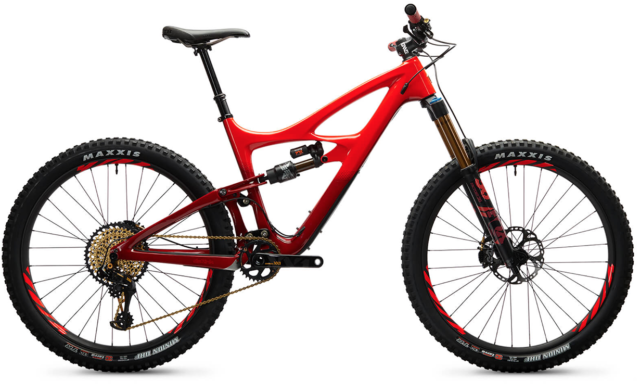
Intro
When Ibis introduced the Mojo a little over a decade ago, it was one of a handful of bikes that defined what modern Trail bikes would become. At a time when bikes tended to fit more cleanly into “Cross Country,” “Freeride,” or “Downhill” molds, the Mojo was one of the bikes that could legitimately claim to be decent at everything.
Eventually, the Mojo lineup expanded to include a “heavy duty” model — the Mojo HD, and we were fans of that bike.
Fast forward to the present, and Ibis is producing the fourth iteration of that bike, the Mojo HD4. And while Ibis still makes a number of do-everything, all-around Trail bikes, the Mojo HD4 is built to be an Enduro bike. Ibis says it themselves: “Built for speed, it excels on steep terrain.”
I’ve spent the last few months on the Mojo HD4 testing it everywhere from Porcupine Rim to Mr. Mulally’s rocky playground at Windrock, Tennessee. So where has the Mojo’s winding evolution taken us? Well, like Ibis says, the HD4 is clearly at home on steeper, rougher trails. But it’s not a one-trick pony….
The Frame
The Mojo HD4 is only available as a carbon frame, and is built around a DW Link suspension design that has been used (with significant tweaks) on all of the Mojo bikes. You can check out our Suspension Designs 101 article for a little more info on that, but essentially, the DW link uses a rigid rear triangle that pivots on two short linkages, sort of like a parallelogram. The shock is actuated by a carbon fiber clevis that allows for an uninterrupted seat tube.
The linkage hardware is all high quality, with oversized bolts keeping everything stiff and secure. This was something Ibis worked on for the Mojo HD4 — a surprising amount of flex can originate from the linkage and bolts, so beefing those up makes a noticeable difference in stiffening the rear end of the bike.
As is fairly standard on carbon frames these days, there are rubber and plastic guards at all the key spots to ward off rock strikes and chain slap. The Mojo HD4’s cable routing is internal, except for the rear brake which (thankfully) stays external. The internal routing ports are easily removable, and large enough to minimize the headache of stringing new housing.
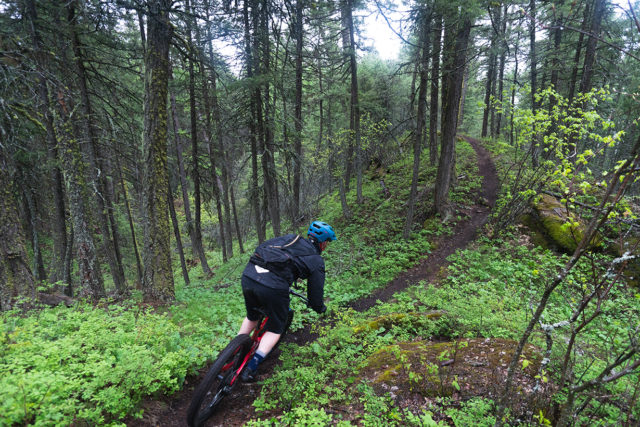
In terms of the Mojo HD4’s frame itself, there are four noteworthy things worth calling out. First, it fits a water bottle in the front triangle. Plenty of bikes in this travel-class don’t, but I like water, and I dislike backpacks, so kudos to Ibis here. Second, the Mojo HD4 has a threaded bottom bracket. Again, props to Ibis for making a bike that creaks less. Third, Ibis makes a frame bag that fits into the space behind the headtube. I haven’t used it, but if I owned this bike I’d probably buy it, because that’s just a great idea.
Fourth, Ibis made a point of making the seat tube both straight and short. The point here is that you can get away with running a really long dropper post. My bike came with a 150 mm dropper, and I could have easily gotten away with a 170 mm, and maybe even a 200 mm dropper. And at 5’9”, I’m not especially tall, so that’s pretty noteworthy.
The downside of that short seat tube is that, with the 150 mm dropper, to get the seat at my preferred pedaling height, I was right at the minimum insertion line on the post. So it wasn’t a problem for me, but if my legs were just a little longer, I would have needed to rustle up a longer seatpost. Bear in mind, though, that I have pretty long legs for my height and I tend to run my seat really high. I think most people will be fine here.
The Build
Ibis offers a bunch of different build kits, and within each build kit there are various upgrade options for the suspension and wheels. I was riding the GX Eagle build, which has a base price of $4799, but my test bike came with the upgraded Ibis 742 carbon wheels, which bumps the price to $5,599.
I spent a bunch of time on the GX Eagle drivetrain last summer, and my opinion remains unchanged — it’s a great drivetrain, and the bang for the buck is pretty tough to beat. I also posted a long-term update on that drivetrain, and all of my time riding the Mojo HD4 has pretty much confirmed my conclusions; GX Eagle isn’t without its faults, but it helps me get up really steep climbs, and it shifts almost as smoothly as its more expensive brethren.
I also spent a lot of time on the Ibis 742 wheels last fall, and again, they’re holding up great. Particularly in Moab and Windrock, I had ample opportunity to ping the rims off of rocks, and they’ve shrugged off all impacts without issue.
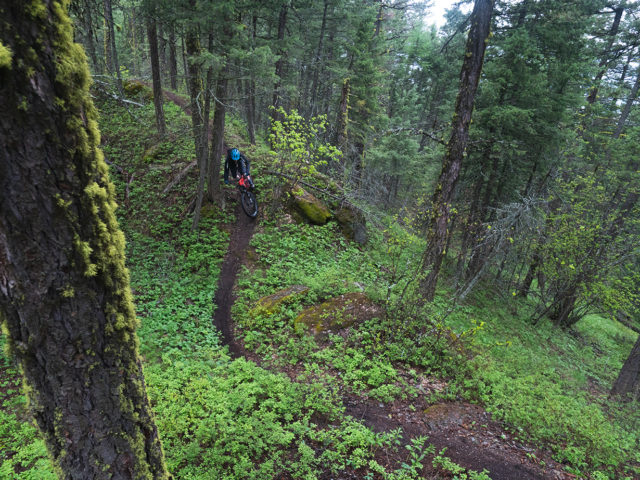
Suspension on the Mojo HD4 is handled by Fox, with a Performance Series 36 up front and a Performance Series Float DPX2 out back. Both are fantastic performers, although it took me longer than expected to get the fork dialed to my liking — with the Grip2 damper in the Performance Series 36, I find that the line between too stiff and insufficiently supportive is a bit narrower than on the higher-end Fit4 dampers.
Up front on the cockpit of the HD4 was a 780 mm wide Ibis-branded bar and stem, and a Cane Creek 40 headset — no arguments there. At the back was a 150 mm KS Lev that worked flawlessly, and had an Ibis saddle attached to it. The saddle was high-quality but a bit too rounded for my taste, but newer Mojo HD4’s come with a WTB Silverado, which seems like a great choice.
My main gripe with the build on the Mojo HD4 was the brakes — the Deore M6000’s perform well, but they developed an air bubble, and I find them a bit fussy to get a good bleed on. But more importantly, Ibis spec’d a 160 mm rear rotor that sometimes struggled on long descents. Apparently, I wasn’t the only one who took issue with that, because the Mojo HD4 now comes with 180 mm rotors on both the front and rear.
My other… hesitation on the build is the tires. This isn’t really a complaint as much as a note — the bike comes with 2.6” Minion DHF’s, or you can upgrade to 2.8” Nobby Nics. Personally, I like the 2.6’s in some situations, but in others, they feel a bit big and slow. I found myself wishing for a more traditional Trail tire, so I mounted up a 2.4” Maxxis Highroller and a 2.35” Schwalbe Hans Dampf. I’ll get into how this changes the ride later on, but the noteworthy thing here is that (1) Ibis doesn’t offer the bike with anything less than a 2.6” tire, and (2) the narrowest rim offered on this bike is still 34 mm wide, so that’s a bit limiting if you wanted to go down to a 2.3” tire. As I’ve said with some other brands that have made similar wheel / tire choices, the stock option isn’t bad, but it might not suit everyone’s taste — I personally wish there was a stock option for something narrower.
Fit and Geometry
The Mojo HD4 comes in four sizes; Small, Medium, Large, and Extra Large. Sizing is fairly average by modern bike standards; the Medium I rode had a 435 mm reach and 604 mm effective top tube. For my 5’9” frame, that’s long enough to feel comfortable both when seated on climbs and while standing for descents, but they aren’t the ultra-long numbers that we see from some companies that are really pushing the boundaries of bike sizing these days. In other words, the Mojo HD4 is modern, but not extreme, so unless you have very specific preferences, I think most people will be happy on their usual size for the Mojo HD4.
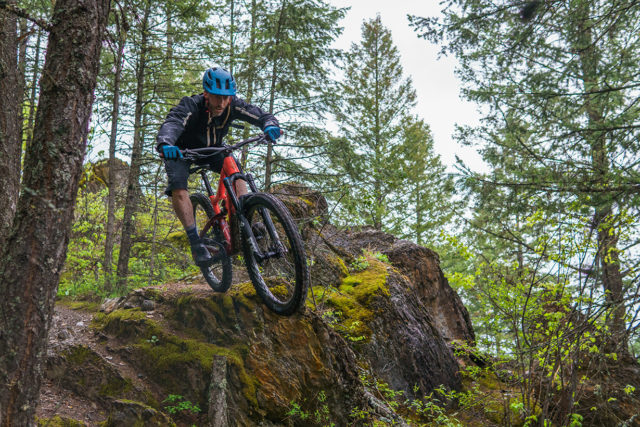
Beyond the sizing numbers, the Mojo HD4’s geometry lays out its intentions pretty clearly. A 64.9° head tube angle is decidedly slack, and that slack front end helps generate the relatively long 1192 mm wheelbase for the Medium I rode. At the back end, 430 mm chainstays are on the short side of average these days. They’re not the ultra-short stays that some companies are trying for, but I’m of the opinion that super short stays corner weird, so I’m happy they’re not any shorter.
A fairly steep 74° seat tube, paired with a low-ish 590 mm stack height (on a Medium) makes for a bike that’s more or less manageable on steep climbs. I don’t want to suggest that the front end doesn’t get a bit wander-y (it does), but at least compared to other similar bikes, the Mojo HD4 is decent when going uphill.
And if those numbers don’t make a ton of sense to you, check out our Bike Geometry 101 and 102 pieces for a primer on angles, measurements, and how to think about them.
The Ride
Every spring, I like to drive down to the desert to knock the winter dust off my legs with some riding in the Moab / Fruita vicinity. Luckily for me, the Mojo HD4 showed up shortly before this trip, so I got to put some time in with the Mojo HD4 in an area that’s ideal for the rough smashiness that the bike’s designed for.
The first order of business was setting up the suspension, and I settled on running a bit less than 30% sag in the back. The Mojo HD4’s suspension feels fairly progressive for the first portion of its travel, which helps the bike stay impressively supple over smaller bumps. Later in the travel, the suspension feels more linear, which (1) means it uses its travel relatively easily, and (2) means I think people could tune the bike to their preferences pretty easily with volume spacers in the rear shock.
Climbing
While the Mojo HD4 does a great job of staying active over smaller trail chatter, that also means that there’s some noticeable bob while spinning along on smoother climbs. It’s not horrendous, and obviously using the shock’s lockout essentially eliminates it, but I like to judge a frame’s efficiency with the shock in “descend” mode. In that setting, it’s pretty clear that the Mojo HD4 prioritizes suspension action on the descents over supreme efficiency on the climbs. Personally, I’m ok with that — I tend to leave the rear shock in descend mode 100% of the time (otherwise I forget to flip it at the top of the climb), and the Mojo HD4 was efficient enough that I didn’t need to change my habits in that regard. I will also say that laying down the power on the Mojo HD4 doesn’t feel fruitless. While there’s a bit of bob there, quick sprints are rewarded by snappy-feeling forward progress.
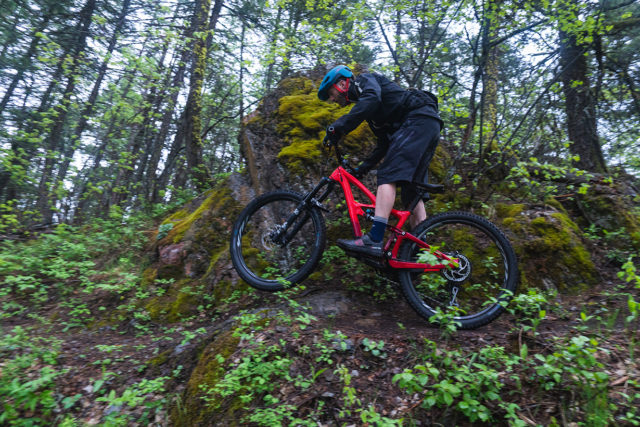
The flip side of a bit of pedal bob is that the suspension stays active on techy climbs, and it does a great job of maintaining traction. On some of the more gravelly, sandy climbs I rode, the Mojo HD4 did a pretty good job of eking out whatever traction is available to keep me moving forward.
Descending
But, of course, the Mojo HD4 isn’t really designed as a climber — it gets you to the top so that you can go down. As fast as possible.
And on the descents, the Mojo HD4 is clearly in its element. That active suspension helps the rear wheel track the ground nicely, and it does quite well at maintaining traction through choppy corners. Helping that situation is a fairly stiff frame — the rear wheel tracks well, and I never got any errant wiggles, even in hard g-outs.
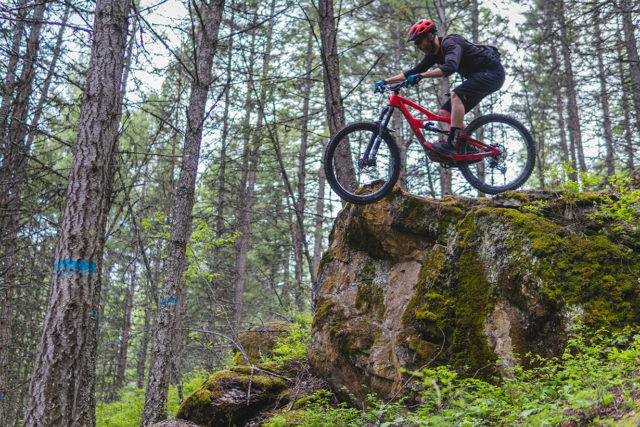
The moderately long front end combined with the slack head angle made for a pleasantly stable ride. At speed, and especially in steep terrain, the Mojo HD4 felt entirely composed. In the steep chunder of Windrock Bike Park, I was able to put my energy into going fast rather than just trying to survive. That longer front end helps the bike punch through holes and smash its way down boulder fields without that constant threat of going over the bars that you get on some shorter, steeper bikes.
Now, that stability comes at the price of some slow-speed maneuverability, but ultimately, I don’t think the tradeoff is too bad on this particular bike. No, the Mojo HD4 doesn’t have the slow-speed prowess of a steeper, shorter-travel Trail bike. But compared to other 150 / 160 mm travel bikes, I’d say the Mojo HD4 is pretty good — it doesn’t feel excessively boat-ish.
In part, I think the Mojo HD4’s handling is helped by the suspension — it feels a bit more poppy and playful than something like a Trek Remedy or a number of longer-travel rigs that are labeled as Enduro bikes. That means it’s easier to load up the Mojo HD4’s suspension and pop through corners, rather than just trundling forward on a bike that feels a bit dead.
Tires
I alluded to this in the build section above. I’m a bit torn on the stock 2.6” tires.
With the 2.6” Minions mounted up, the Mojo HD4 rode extra smooth — the suspension does well, and the tires smooth things out even more. And yes, big tires get great traction… sometimes. In gravelly, sandy corners, the big tires are fantastic; they hook up well, or at least hook up as well as possible as I’m haphazardly drifting towards what appears to be the apex of the turn. But in better dirt (which is more common here in Montana), the big tires feel unnecessary, and I actually feel a bit more locked into corners on narrower tires where it’s easier to really maintain pressure on the side knobs.
But more importantly, the bigger tires just feel a bit slower and less precise. They accelerate a bit slower, they roll a bit slower, and in technical terrain, I find it takes a little more work to make the tires stay exactly on the line I want.
None of these are major gripes, and I fully understand why people like them. Recently, I was on a bike mounted with 2.3” tires, and I followed a guy on 2.6” tires through a bunch of fairly flat, sweeping, gravelly turns. He held speed through the corners, while I was doing everything I could to keep up. So yeah, there’s no question that the 2.6’s (and 2.8’s, for that matter) have their place.
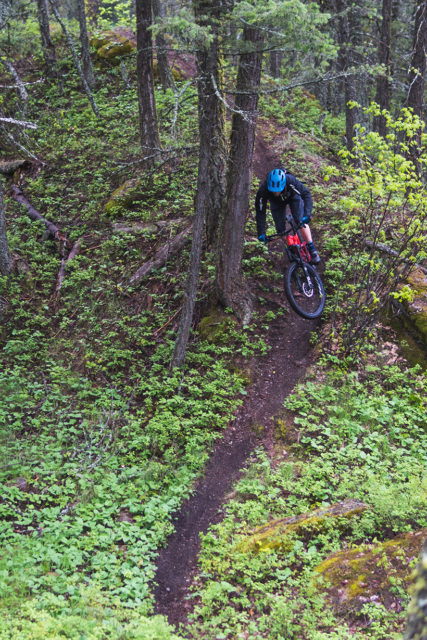
But back to the Mojo HD4: as I said in the build section, I swapped on a 2.4” Maxxis Highroller II in the front and a 2.35” Hans Dampf in the back. Don’t read too much into my specific tire choices there — those just happened to be what was lying around my garage. But swapping to those tires really changed the bike for me. With the big tires on, I thought the bike was good, but it felt just a little lacking in a way I couldn’t quite put my finger on. With the narrower tires (which, as of a couple years ago, would have been considered relatively wide), the bike really came alive. It felt quicker and snappier through corners, it accelerated with more authority, and all in all in just felt more lively.
With a quick tire swap, I’m all of a sudden doing my best Jeff Kendall-Weed impressions; popping off every little hit on the trail and trying to manual every piece of trail that’s straight for more than five feet.
And that’s all a lot of fun, which is maybe how I’d define the Mojo HD4. It’s entirely capable of the serious business of going fast down rough trails. But it still retains some of that poppy playfulness that’s all too often lost as bikes get bigger, longer, slacker, and radder. And I think for most people that’s a good thing. Companies like to market their longer-travel bikes as Enduro weapons, but I didn’t do a single race on the Mojo HD4 and I still had a bunch of fun ripping around on it, which is (hopefully) the point.
Some Comparisons
Specialized Stumpjumper / Enduro
I’m grouping the Stumpjumper and Enduro together because I think the Mojo HD4 falls somewhere in between them, although more at the Enduro end of the spectrum. The Mojo HD4 is more bike than the Stumpjumper — while they’re in the same ballpark in terms of travel, the Mojo HD4 is a good bit slacker, and it’s designed with a bit more emphasis on the descent. While I think the Specialized Enduro probably feels like a bigger bike than the Mojo HD4, those two bikes are definitely a bit more comparable. Compared to the Enduro, I’d say the Mojo HD4 is more playful and more feasible as a Trail bike, but gives up some ground in straight-line, high-speed destruction.
Trek Remedy
I’m comparing the Remedy RSL here since that’s what I’ve spent the most time on. The Remedy RSL and Mojo HD4 are pretty similar in many respects: similar travel, similar geometry, and ultimately, somewhat similar on trail. Both are similar climbers, although the Remedy gets the nod on steeper, techier climbs. When descending, the Remedy is more inclined to stay low and smash, while the Mojo HD4 feels more nimble and poppy. Both are quite stable, although the slightly longer front end on the Mojo helps push through awkward holes a bit more.
Santa Cruz Bronson / Nomad
I haven’t ridden the new Nomad, so there’s some speculation here. But like the Specialized options, I think the Mojo HD4 falls between the Bronson and Nomad — it’s more bike than the Bronson, but not quite as burly as the Nomad. The Bronson is a better climber than the Mojo HD4, but when things point downhill, the Mojo HD4 is more stable and more capable. But (probably) not quite as purely downhill-oriented as the Nomad.
Pivot Mach 5.5
On paper, the Mach 5.5 and the Mojo HD4 have a lot in common: similar travel, similar suspension design, and similar 2.6” tire choice. But on the trail, they’re a bit different. Namely, the Mojo HD4 is considerably slacker, and errs more on the side of descending prowess than all-around versatility. The Mach 5.5 is perhaps a bit more efficient on climbs, and it’s less wander-y when the uphills get steep. But the Mach 5.5 is not nearly as stable on descents, and it doesn’t smash through things with quite the ease of the Mojo HD4.
Also, check out our 27.5” comparison guide to see where we placed the Mojo HD4 compared to a bunch of other bikes.
Durability and Maintenance
I don’t have any noteworthy issues to report. I crashed the Mojo HD4 a few times and it came out relatively unscathed. In one of those tumbles, I did bend the derailleur hanger, and the noteworthy thing there is that the derailleur survived without damage. Which is a good thing — I’ve ridden plenty of bikes that have replaceable hangers, but they’re so stout that the derailleur will explode long before the hanger bends. So yeah, the $30 hanger on the Mojo saved a $125 derailleur.
Bottom Line
There’s no shortage of great Trail bikes on the market these days, and Ibis makes several of them. And there’s a decent number of longer-travel bikes that really emphasize the downhill. Somewhere in between those points lies the Ibis Mojo HD4. Yes, it’s built with descending in mind, and it’s clear that steep, rowdy descents are where it’s most at home. But it’s not quite as singularly focused as some of the longer-travel options out there that would really prefer to get driven to the top of the hill.
And yes, there’s also no shortage of bike reviews that basically read “climbs great, descends even better.” So to narrow this down a little bit, I’d say the Mojo HD4 hits the inflection point of “most downhill-oriented bike that I’d still be willing to pedal uphill for a really long time.”
In other words, if you’re all about the descent, but you still (regularly) pedal big vert to get to the top of things, the Mojo HD4 is for you. There are bigger bikes that pedal ok, but those get into the territory of bikes that I’d hesitate to regularly take on big rides. And there are smaller bikes that are clearly more efficient and quicker up climbs, but they give up some ground on the fun parts of the ride.
The Mojo HD4 is light enough and comfortable enough going uphill to be acceptable for longer climbs, but all the while, you know that the point is still to get a ridiculously fun descent on a bike that’s not going to hold back. And yeah, at the risk of being repetitive, the Mojo HD4 is a really good time on the way down.

Great review–well written; all meat, no filler. Not sure I’d call a 74 degree seat tube “fairly steep,” personally, but whatever, 74 degrees is 74 degrees.
Nice review. The latest Pivot Mach 6 is very similar now to this HD4. A tad less slack. Would like to see your impressions on it as it should be more comparable than the 5.5. But nice to see comparisons up and down categories as well, not enough of that stuff from other reviewers.
I rode both the HD4 and the Mach 6 back to back on fresh legs at Dirt Fest last month at Big Bear Campground here in WV and to be honest they had a few similarities but to me the HD4 blew the Pivots away on the climbs and especially on the decents. The Pivot bikes are nice to but the Ibis was like butter smooth everywhere and the grip from the 2.6 Minions were awesome. Oh the Mach 6 and HD 4 I ride were spec’d, identically suspension wise but had the GX Eagle on the HD4 and Shimano in the Mach 6. If I’m buying (which I will be getting 2 soon) the Ibis HD4 is getting the nods for both me and my son over all others that we tried period!!
I suggest you check your local shops and get each out for a demo and form your own opinion because you might not like what we do.
Btw me and my son are 5’11” and rode large frames.
oh and could you comment on your stem/size: could you have gone with a large frame?
Great review! Thorough, and very informative. My HD4 is shipping later this week, and this just helped re-kindle the stoke after my lengthy wait! :)
I’m also interested in more on sizing. I’m also 5’9 and fall between the medium and large. What’s your opinion on stepping up to a large with a shorter stem? Or medium with a longer stem? Did you ever feel like you could use more room? Benefit from a longer wheelbase? Great review!
Very good review except for one small point, Ibis derailleur hangers are $15.00 not $30.00 ;)
Great review, I particularly appreciated your comments about tire size and the comparisons with other bikes here. I’m currently looking at the Ibis HD4 and SC Bronson so your commentary is very relevant for me!
Based on the date of this review, I’m guessing he’s referring to the older bronson not the new one. I’ve been told the new bronson rides bigger than the hd4. I own the hd4, but I wish i could run a coil other than that this review is pretty accurate. The HD4 is an awesome bike, its fantastic on long rides. Its my go to bike in moab, fruita, and sedona. On smooth flow trail with more climb and sprinting i.e., colorado trail, most of crested butte, I ride my pivot trail 429. The ripmo gets all the hype, but the hd4 is just as good if not better.
Hey Noah, Great review! I particularly like your comparison of the HD4 to other bikes. Your review convinced me to get an HD4 for this riding season. With the Fox X2 shock, the HD4’s travel really feels bottomless. I have to say that your comment “most downhill-oriented bike that I’d still be willing to pedal uphill for a really long time.” is spot on. Responding to an earlier comment, I found the current Pivot Mach 6 to be not quite as downhill oriented as the HD4 though both do great going downhill. The Mach 6 feels remarkably close to the Turner RFX in both climbing and descending feel. BTW, great review of the Esker Elkat as well!
Also, I rode the Revel Rail earlier this year as well. It was similar in downhill capability to the HD4 but a bit different in how it went about achieving that capability.